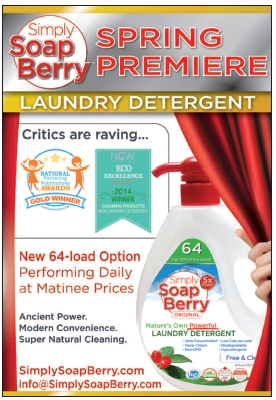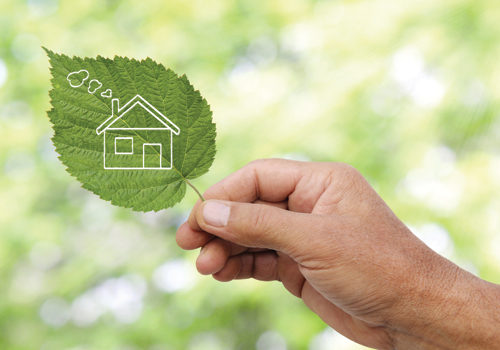Cooking. Cleaning. Organizing. These routine tasks can add up, not just in time or in money, but also in environmental impact. As the consumer base grows more eco-conscious and terms like safety and sustainability become viable selling points, alternatives to traditional offerings become popular. This is a main element behind the rise of green household products, a category that has steadily grown over the last few years with little sign of stopping.
A 2012 report from Packaged Facts said that green cleaning product sales totaled $640 million in 2011, up from $303 million in 2007. Survey data in the report also revealed that more consumers have purchased or used natural, organic or eco-friendly household cleaning/laundry products within the previous 12 months than they did three years ago. Along with these sales comes increased interest—and shelf space—from both natural and mass-market retailers.
With these findings, though, come concerns. The authors of the report noted that while sales were up, so was skepticism, with one-third of consumers thinking that green household products were less effective than their traditional counterparts, a number that had actually increased over time (1). For green household products to continue this trend of success, product makers need to dispel this by demonstrating value and efficacy to their consumers, and the way to do this is through innovation.
In The Beginning
To figure out what can be done to keep this positive surge going, it’s important to revisit what caused that initial explosion of popularity. Jenna Arkin, product development director at Earth Friendly Products, Addison, IL, believes that it was partly due to a growing demand for green products in general, stemming from “consumers becoming increasingly educated about the products they bring into their homes and expose their families to.”
Toni Desrosiers, founder and CEO, Abeego Designs, Inc., Victoria, BC, Canada, echoes this sentiment, noting that as recently as 2008, her company’s beeswax food wraps were purchased mainly by a niche consumer segment. Things have changed over the last few years as “the general public is faced with new information daily,” she adds. Many consumers are also beginning to lose faith in conventional options as information comes out on safety and environmental impact. Not everyone is willing to make the switch just yet, but the number of converts is slowly growing.
Victoria, BC, Canada, echoes this sentiment, noting that as recently as 2008, her company’s beeswax food wraps were purchased mainly by a niche consumer segment. Things have changed over the last few years as “the general public is faced with new information daily,” she adds. Many consumers are also beginning to lose faith in conventional options as information comes out on safety and environmental impact. Not everyone is willing to make the switch just yet, but the number of converts is slowly growing.
While our experts agreed that green household products are on the upswing, some noted that there might be some issues on the horizon. David Janow, president and CEO of Axiom Foods Inc., Los Angeles, CA, remarks that while “absolutely, the percentage of green household cleaners will continue to overtake the market as new products can prove they are as convenient and effective as the potentially toxic forefathers,” there may be bumps in the road. As he explains it, if consumers invest in a green cleaning product and are not satisfied with the results, they tend to go back to conventional choices rather than risking further “trial and error.” Education, from both manufacturers and retailers, is important to prevent this “bounce-back” to conventional choices, along with innovation. Think of innovations as the initial lure to get consumers curious about green household products, and education as the foundation to turn curiosity into conversion.
Innovations: Effectiveness
The “bounce-back” issue reminds us that while being eco-friendly and safe are great selling points, consumers ultimately want an effective product, and steps are being taken to provide just that. Chance Claxton, co-founder of U•Konserve, Scottsdale, AZ, says that new developments in food storage may make green options the most effective as well as the safest choice. She explains that “the introduction of glass with silicone sleeve for protection is the perfect receptacle for heating in a microwave. Many brands can also go directly from freezer to heat which is a tremendous convenience and timesaver.”
Desrosiers notes that this category is also moving forward by moving backward, with the ordinary canning jar’s transformation into a multi-use vessel “one of the best ‘old meets new’ eco designs” she’s seen. Several of our experts see the revival of the canning jar as a great example of green equating to versatility which can be another selling point.
Innovations in effectiveness are every bit as dependent on finding new materials as on new design choices. Janow harkens back to his earlier statement about customers going back to conventional options, saying, “some green surfactants are not as effective as consumers would like, while other ‘green’ products are not using truly ‘green’ surfactants.” To this end, his company offers a detergent utilizing Himalayan soapberries, which not only serve as a natural cleanser, but also as a natural deodorizer and softener.
Communicating the multifaceted nature of some of these green choices to consumers is a big way to keep them interested for the long haul, and this is where retailers can make a difference, say Barry Firth, general manager and Cindy Rimer, vice president of sales and marketing at Biokleen, Vancouver, WA. Taking the steps to communicate figures like cost-per-load allows the consumer to make a more educated decision when choosing a product rather than taking a blind step and finding something that doesn’t suit them, they explain. Product guarantees for returns if something doesn’t work can also alleviate some of that “bounce back” fear. Ultimately, when it comes to effectiveness, the retailer can be the one to help make sure consumers find what is most effective for them.
Innovations: Sustainability
While communicating effectiveness is an important part of making green household products appealing, when people think green, two buzzwords spring to mind: safety and sustainability, from the initial materials to the finished product.
On the safety side of things, Arkin explains that “transparency in green products is key to safety; in order for consumers to be able to protect their families, they need to have information about what a specific product contains.”
Desrosiers agrees on the newfound importance of transparency, saying “the days of ‘secret formulas’ and ‘family recipes’ are long gone. These marketing terms no longer create the intrigue they did in the past.” Instead, she explains that trust has become a more powerful sales draw, and the combination of transparency and responsibility is a great platform to begin establishing it.
Charlie Ortega, vice president of food and beverage at Hydro Flask, Bend, OR, adds that much of the verbiage that his company uses is geared toward establishing said trust and being “very intentional about mapping anything we do back to our values and who we are as a company.”
In the education process, though, Arkin suggests staying away from what she calls “guilt-based marketing.” Consumers that feel that their habits are being attacked as destructive to the environment will ultimately be turned away or see such claims as “green-washing,” she explains. Instead, safety and sustainability education should “encourage the consumer to make the changes that suit their lifestyle and be eager to purchase products that make them feel good.”
|
Select Eco-Friendly Home Products
Abeego Designs: Abeego reusable beeswax food wrap. |
|
Safety is always a concern, but especially so for household products because much of the consumer base is shopping for a family. Firth and Rimer point out that accidental ingestion is one of the most common household accidents with children, and offering safety advice and clear disclosure on ingredients that can be harmful to children is important. Considering the general perception that natural household products are supposed to be the safer alternative, companies should do everything in their power to push that narrative. Claxton points out that several food storage companies are doing just that, “developing products that eschew ingredients such as PVC, lead, phthalates and BPA, which had been used in children’s and food storage products in the past.”
While some consumers may see safety as a more immediate concern, sustainability is also becoming a viable selling point, and innovations are helping to push this. Some of the biggest steps toward sustainability are the manufacturing, according to Arkin. She mentions that her company currently uses solar power to help in its manufacturing process and has recently achieved carbon neutrality.
While sustainable manufacturing can pay dividends for the environment and wallet, another strong area is sustainable materials in products and packaging. Jim Lamancusa, vice president, sales and marketing at Eco Vessel, Boulder, CO, says that when it comes to choosing materials for packaging, “recyclability and biodegradability are two buzz terms right now.” His company is taking advantage by using stainless steel in its food storage products, which as he explains, offers “zero leaching and is also recyclable at the end of life.” Ortega also adds that promoting the idea of reusing until the end of life and then recycling ensures maximum sustainability.
Firth and Rimer note that some regulations are giving the sustainable movement support for growth, like the FTC green guides that “have helped ensure a level playing field by requiring/requesting that companies be able to back up/and or define biodegradable claims.” Lamancusa adds San Francisco banning single-use water bottles as another example of legislation making sustainable products more appealing, even for those who may not have been all that interested before.
Innovations: Savings
While environmental concerns are certainly factoring into consumers’ purchases these days, there is also a more immediate positive yield you can appeal to: the bottom line. While the savings opportunities from green household products may not be always be apparent at the register, the same idea of renewability that helps the environment can also help the wallet. Lamancusa puts things in the clearest of terms: “the average cost for a bottle of water is $1.45. So replacing that cost with a reusable bottle will equal a cost savings after about 15 uses.” With the long lifespan of a reusable bottle, these savings can accumulate rather quickly. Claxton adds that reusable food storage, both on the go and at home, can also rack up savings over time. She estimates that “switching to reusable containers and food in bulk can save over $200 each year just for one school-age child.” Some of these reusable options her company offers include items like bamboo utensils, stainless steel straws and recycled cotton totes.
The idea of reusability as a method for savings can serve as an education opportunity for your consumers, and pointing them toward green products and ways to save their money helps build that valuable trust. Andy Keller, president and inventor, ChicoBag, Chico, CA, notes that it’s possible to “no longer spend money on paper towels…we don’t buy baggies. We also realized you don’t need 10 different bottles of cleaners to clean our house.” Turning consumers onto multipurpose items will ultimately save them money and can create repeat customers in the end. The financial benefits are not consumer-exclusive, though. As Arkin explains, “green products save money by reducing waste, reducing energy consumption required to produce the product, and often require less overall processing.”
Where to Next?
Earlier, many of our experts said the green household products category would continue to grow steadily despite some potential bumps in the road. In addition to what’s already on the market, many of them see potential for the category in household items that have strong potential to go green in the future. Originally, household cleaners were the main item in green household products, and in the public eye, still are, with Keller noting that brands like Mrs. Meyers and Dr. Bronner’s are now appearing at mainstream retailers like Costco. Judging from impressions, it appears that natural food storage and kitchenware may be the next natural trend to cross over into the mainstream.
Desrosiers describes the current atmosphere as “the tipping point” for natural food storage. “For the last six years, companies have been innovating in this category and the market now offers attractive products that are logical and inspiring,” she explains. She predicts that mainstream retailers will develop an interest in natural food storage within the next three years.
Janow agrees on this trend, but offers a different reason why, saying that “the food we consume is in contact, thus we digest unnecessary toxins.” Many of the health concerns that are driving consumers to healthier food items could leak over into safer and sustainable storage. Janow sees more mainstream household companies extending into the green market as these trends play out as well, taking the opportunity to build repeat purchases from consumers looking for a newer model that is better for their home, planet and wallet. WF
Reference
1. Packaged Facts, Green Cleaning Products in the U.S., www.packagedfacts.com/Green-Cleaning-Products-7114196, accessed 1/28/2015.
Published in WholeFoods Magazine, April 2015










